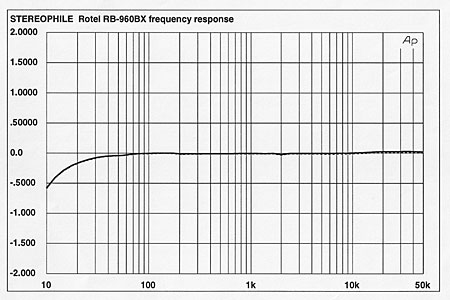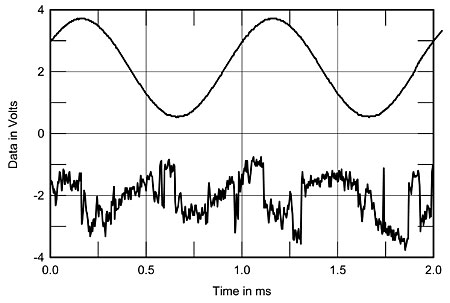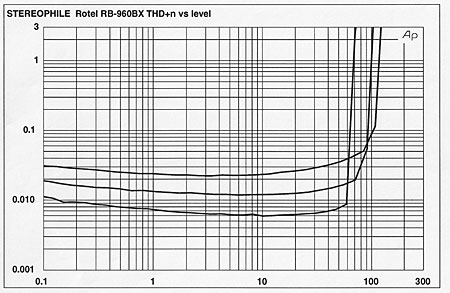| Columns Retired Columns & Blogs |
looks like a decent design.
The Rotel RB-960BX was also hot to the touch after preconditioning at 1/3 power. Its input impedance measured 28k ohms, its 8-ohm gain 27.4dB. The output impedance was below 0.04 ohm from 20Hz to 1kHz, and rose just slightly to under 0.55 ohm at 20kHz. DC offset measured 2mV in the left channel, 1mV in the right. Signal/noise (unweighted at 1W into 8 ohms) measured 90.3dB. The Rotel is noninverting, a positive-going signal at its inputs remaining positive at the outputs.
Fig.1 shows RB-960BX's frequency response at 1W into 8 ohms—virtually flat above 100Hz and with only a negligible rolloff at the low end. The response at 2W into 4 ohms (not shown) was virtually the same, the only difference being a 0.1dB rolloff at 50kHz with the lower impedance load. This extended high-frequency response is reflected in the 10kHz squarewave (fig.2), which is virtually flat on top with only a hint of overshoot. The 1kHz squarewave (not shown) deviates from a textbook result only in having a slight tilt at the top and bottom, reflecting the amplifier's extreme low-end rolloff.

Fig.1 Rotel RB960BX, frequency response at 2.83V into 8 ohms (right channel dashed, 0.5dB/vertical div.)

Fig.2 Rotel RB960BX, small-signal 10kHz squarewave into 8 ohms.
The crosstalk (fig.3) is nearly symmetrical between the two channels. The channel separation, while not exceptional, is unlikely to cause any audible degradation. The gradual increase in crosstalk as frequency increases is typically due to capacitive coupling between channels, and is common in most stereo components where the two channels are in close proximity.

Fig.3 Rotel RB960BX, channel separation at 100Hz): L–R, R–L (5dB/vertical div.).
The Rotel's low-power THD+noise (fig.4) remains low across the frequency range, with a modest rise in the upper octaves and with decreasing load impedance. The waveform of the THD+noise residual at a 5.5W output into 4 ohms, with the 1kHz fundamental notched out, is shown in fig.5. While the main component of the distortion is clearly second-harmonic, the uneven nature of the curve also indicates higher harmonics, along with the inevitable noise components. The waveform is slightly more erratic into a 2-ohm load and slightly smoother into 8 ohms (neither shown), but the main component remains second-harmonic.

Fig.4 Rotel RB960BX, THD+N (%) vs frequency at (from top to bottom): 4W into 2 ohms, 2W into 4 ohms, 1W into 8 ohms (right channel dashed).

Fig.5 Rotel RB960BX, 1kHz waveform at 5.5W into 4 ohms (top), distortion and noise waveform with fundamental notched out (bottom, not to scale).
The distortion spectrum of the RB-960BX with a 50Hz input and an output of 67W into 4 ohms is shown in fig.6. There is power-supply–related noise visible (120Hz at about –80dB (ref. fundamental), and again at 240Hz at about –95dB). The distortion components are low, however. The second harmonic (100Hz) is the highest at –72.4dB or 0.025%. The third harmonic (150Hz) is –82dB or 0.008%. Fig.7 shows the Rotel's response to a combined 19+20kHz signal—the intermodulation of these two frequencies—at 57W output into a 4 ohm load (the maximum power output available with this signal into 4 ohms without clipping). The highest-level artifact here is at 21kHz—61dB down, or about 0.09%. The distortion decreases in the mid-treble, increasing again at lower frequencies and reaching a peak at 2kHz of –67dB, or just over 0.04%. The equivalent spectrum at 36.7W into 8 ohms (not shown, and, again, the highest power output short of clipping with this signal at this impedance) shows the same pattern with marginally lower distortion in some regions (particularly the higher treble) and higher distortion in others (the mid-treble). The changes, however, are actually very small on an absolute basis.

Fig.6 Rotel RB960BX, spectrum of 50Hz sinewave, DC–10kHz, at 67W into 4 ohms (linear frequency scale).

Fig.7 Rotel RB960BX, HF intermodulation spectrum, DC–22kHz, 19+20kHz at 57W peak into 4 ohms (linear frequency scale).
The 1kHz THD+noise vs level curves for the Rotel are shown in fig.8. Discrete clipping (1% THD+noise) occurred at 63.2W (18dBW) left and 64.4W (18.1dBW) right, 114V line, both channels driven, and 68.2W (18.3dBW), 117V line with a single channel driven into 8 ohms; 84.4W (16.25dBW) left and 84W (16.2dBW) right, 110–112V line, both channels driven, and 89.6W (16.5dBW), 113V line, with a single channel driven into 4 ohms; and 108.9W (14.3dBW), 115V line, with a single channel driven into 2 ohms.

Fig.8 Rotel RB960BX, distortion (%) vs 1kHz continuous output power into (from bottom to top): 8, 4, 2 ohms.
The Rotel's power output was slightly lower than that of the Adcom GFA-535 II. Unlike the Adcom—and despite the fact that both have separate power transformers for each channel— the Rotel's power output with a single channel driven was slightly higher than it was with both channels driven. Like the Adcom, however, the Rotel blew fuses during the testing, though not during the clipping-level tests; the blown fuse was discovered the next time the amplifier was switched on. (Thus a second sample was used for the squarewave, distortion waveform, and 50Hz spectrum tests.)
The Rotel can also be used as a monoblock in bridged configuration. The frequency response in this mode (not shown) was virtually unchanged from the unbridged mode. The distortion increased marginally over that for the normal stereo configuration, but the change is not significant. The bridged THD+noise vs level results shown in fig.9 indicate that the Rotel will put out over 150W into 8 ohms in the bridged mode (21.75dBW) before its distortion heads north, and that it will also do at least as well into 4 ohms, though at generally higher levels of distortion. The Rotel's maximum power delivery was not checked in the bridged mode into 2 ohms; using a conventional solid-state amplifier in a bridged configuration into low impedances is generally undesirable (footnote 1).

Fig.9 Rotel RB960BX, bridged mode, THD+N (%) vs frequency at (from top to bottom): 2W into 4 ohms, 1W into 8 ohms (right channel dashed).

Fig.10 Rotel RB960BX, bridged mode, distortion (%) vs 1kHz continuous output power into (from bottom to top): 8, 4 ohms.
Like the Adcom GFA-535 II, the Rotel RB-960BX could not match the doubling of output with each halving of load impedance, something that's achieved by much larger and more expensive power amplifiers that have power supplies capable of driving an AC distribution network. But the Rotel's test-bench performance, though not really exceptional in any particular area—what would have been exceptional performance a few years ago is today taken for granted—displayed no measurable weaknesses that might audibly limit its performance when the amplifier is used within its power rating.—Thomas J. Norton